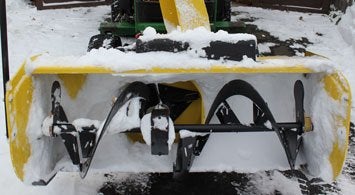
With winter firmly established, that means snow across much of North America. For some time we’ve wanted to review the John Deere 47” snowblower, a model used in the X700, 1000 and 2000 series tractors. When our local dealer informed us that a longtime customer had just upgraded from a single-stage 46” snowthrower and would allow us to test it against the elements of an upcoming predicted snowfall, we were all grins.
The 47” blower covered by this review gets John Deere’s Operator’s Manual OMLVU1840 and is not to be confused with the 47” blowers used by the X500 tractors. This series blower requires a quick-tach front hitch, which differs slightly depending on the series tractor it is intended to be mounted on. For the 2210 tractor used in this test, the hitch is model BM20921, and with the driveshaft and front PTO necessary, runs in the vicinity of $1000—not including the blower itself. Good thing the quick hitch is compatible with a variety of other implements including a plow and rotary broom.
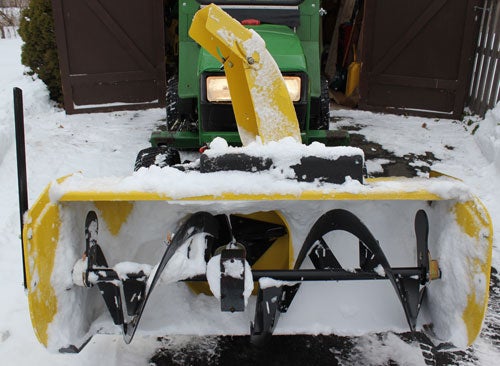 |
The owner of the test set-up who wishes to remain anonymous used a 46” single-stage snowthrower for 17 years, first on a 425 and then keeping the unit when he upgraded to a 2210. The snowthrower served him faithfully over the course of many New England winters, but for some time he had his eye on a two-stage unit for the differences in how they operate.
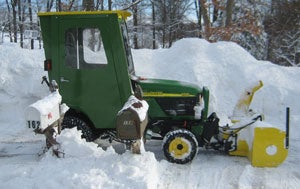
For those unfamiliar with single-stage blowers, they work by forcing the intake charge (snow) into the chute which requires careful modulation of ground speed as well as engine rpm. This is best suited to a hydrostatic transmission where the operator can control the modulation via foot (or hand) depending on the machine. A two-stage blower has a powered main auger that “cuts” into the drift and by rotation moves the intake charge to a second impeller (stage) where the fan blows the snow out the chute. Both systems perform well, but where a single-stage requires mostly high but varying control over ground speed, a two-stage is consistent enough to be run on cruise control.
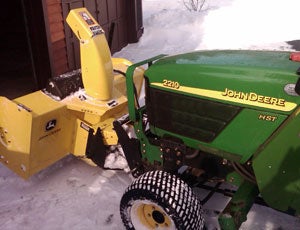
Our test blower has a unit weight of 240 lbs, so counterbalance weight is recommended on the X700 series units. Even on the 2210 we tested the unit on, the owner had the rear tires “loaded” with RimGuard, which adds approximately 80 lbs. to each tire. Current 1000/2000 series owners in the market for this blower should consult with their dealer as to required counterbalance weight. Chains are another option that may be necessary in your climate and geographical location.
Attaching the 47” blower to the quick hitch is as easy as driving the tractor, hitch lowered, to the blower and lifting the hitch using tractor hydraulics. Two pins on the blower contact a cradle point on the hitch and if everything doesn’t snap on its own into place two spring-loaded levers can be twisted to lock the blower in place. The driveshaft uses Deere’s collar coupler that can be pulled back and slipped onto the spline using one hand. Do this with the engine not running for safety’s sake. The four hydraulic hoses require a selective control valve (SCV) to already be installed on the tractor and are color coded (green, black, yellow and silver). Jogging the SCV joystick or turn signal stalk control is always recommended as this will alleviate pressure and allow the quick couplers to easily connect. That’s as simple as attachment gets. To detach the blower, just reverse the above order.
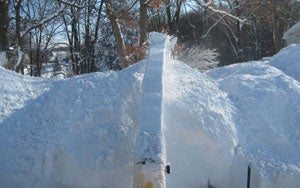
The current generation of 47” blowers use a heavy-duty skid shoe and reversible scraper blade. These shoes are made of thick fabricated metal and are a much better design than previous generation where the shoes were stamped and much thinner. The cutting scraper blade is designed to sit slightly higher, allowing the thicker skid shoes to take most of the abuse. We can easily see many seasons of life for these new design shoes if properly set up and conceivably they could mirror the life of the blower. Maintenance is as easy as lubricating the discharge chute before each use, adjusting and lubricating the drive chain at the beginning of the season, greasing the driveshaft every 25 hour and checking gearbox oil level at the same interval. Chute rotation on the 47” blower is via hydraulics and uses a hydraulic cylinder and cable arrangement that has been proven to stand up well in winter conditions.
So how does it all work? In the 8” or so of light, fluffy snow Mother Nature delivered for our test, the 47” blower with 23 gross/17.1 power take off (PTO) horsepower didn’t protest at all. Using the tractor tachometer to gauge PTO rpm – on the 2210 2900 engine rpm equals 2100 PTO – we found the throttle could easily be backed down with little decrease in performance. Talking to the owner, he mentioned the heavy, wet snowfall several days earlier might have made the engine work a tiny bit harder, but that was it.
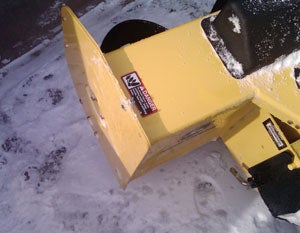
The drift knife mounted on the right side (we can’t figure why Deere doesn’t include one on the left other than cost) cut cleanly and left a nicely defined edge. Left-right chute control was snappy (much faster than on the 46”) using tractor hydraulics, but the upper chute adjustment is manual. Deere does offer an optional cable-operated kit for those trying to more precisely aim the discharge. Discharge distance in the abovementioned snowfall was 10-15’ and more than high enough to clear a 5-6’ tall snowbank. An option our test blower had and that we would recommend is the strengthening end plates. They run approximately $120 each, but add much more rigidity to the blower ends, which are pretty thin and prone, we’re sure, to catching and bending on those hidden surprises snowblowers often seem to find.
If you’re in the market for a snowblower but can’t relish the thought of craning your neck rearward with a cheaper rear three-point hitch (3PH) blower, check out the John Deere 47”. We think you’ll be impressed. We were.
Related Reading
2011 Wallenstein BX32 Chipper Review
2011 Bush Hog 296 Rotary Cutter Review
 Your Privacy Choices
Your Privacy Choices